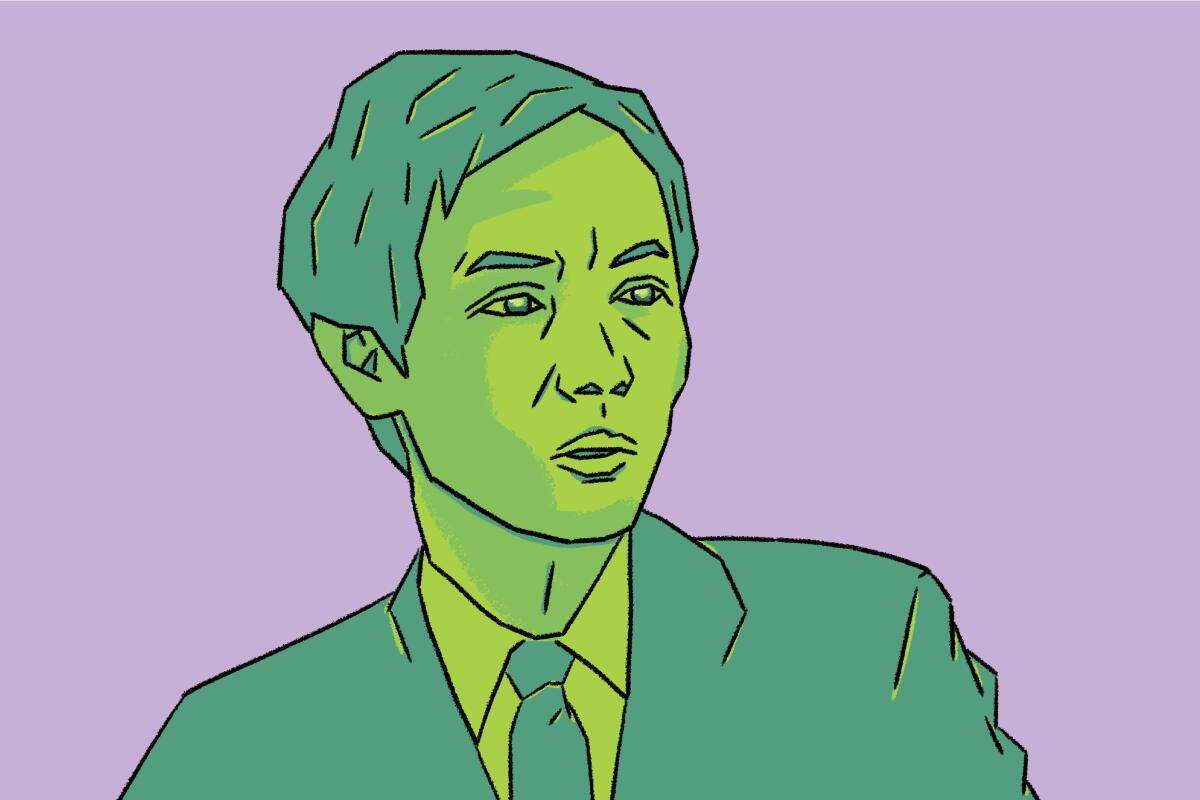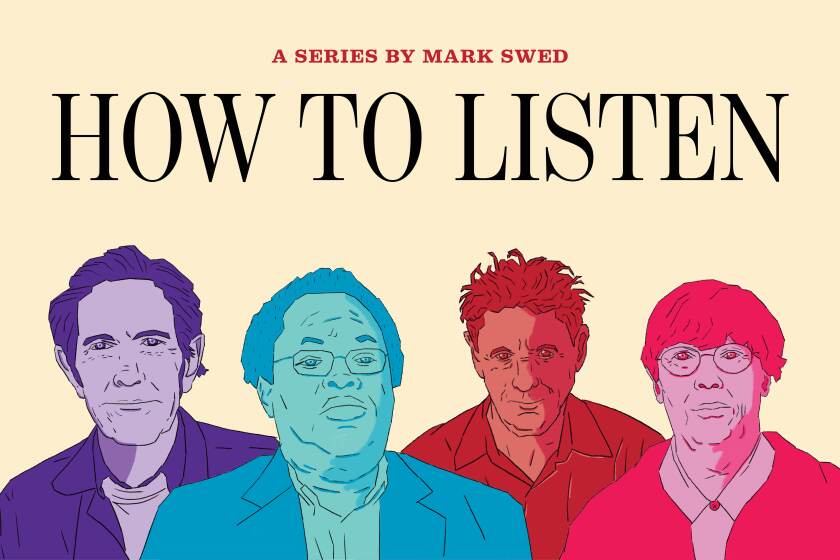How do you bridge a cultural divide? Listen to Toru Takemitsu’s ‘November Steps’

In the early 1980s, a British writer living in Japan decided that, as a Westerner, he couldn’t understand Japan unless he walked its 2,000-mile length. As Alan Booth recounted in his marvelous book about the trek, “The Roads to Sata,” a Japanese friend at his farewell dinner in Tokyo told Booth that he should count the number of steps he takes. Why? Because no one knows how many it takes to cross Japan.
In fact, 15 years earlier, a Japanese composer, holed up in Nagano prefecture in central Japan with a pair of scores by Debussy for inspiration, came up with a way to traverse the 6,700 miles separating his piano and New York in just 11 steps. Toru Takemitsu was writing “November Steps” for traditional Japanese instruments and the New York Philharmonic, an experiment in authentically bridging East and West in classical music in ways never before thought feasible.
These steps can connote the dan, the sections in Japanese Noh theater, but only in a vague way. Takemitsu further suggested that they are variations, although they’re not really.
It turns out to be easier to say what “November Steps” is not rather than what it is. The score is not cultural appropriation. The California roll wouldn’t have its first mention in The Times for an additional dozen years, and, although the 36-year-old composer who was the leading light in making a new kind of music from Japanese and Western sources, Takemitsu was having nothing to do with palatable musical fusion.
What Takemitsu was after in a strange and radical work — one that grabs a listener by the lapel, with hard shakes and rattles and shoves — is a dialogue that is no dialogue at all. There is no agreement because agreement is beyond point, because there is no right or wrong. There are no power plays, no dominant or secondary roles played. Like birds singing in a forest full of other sounds, there are only differences.
Takemitsu didn’t originally plan to use the title “November Steps.” He told the New York Philharmonic it would be called “Water Rings” until the painter Jasper Johns noted that Americans would miss the metaphysical meaning. For them water rings are the scum left in a dirty bathtub. All the better, Takemitsu thought, to illustrate the role language plays in cultural exchange, but he politely took the advice and pointed the title specifically toward the upcoming November premiere and with yet another meaning.
This score was a new step for world music, for the composer, for American orchestras, for the up-and-coming Seiji Ozawa (who conducted the premiere and made the first recording), and for the whole thorny issue of race relations that ever more demands our attention.
“I don’t like things that are pure and refined,” Takemitsu said in the 1994 documentary “Music for the Movies: Toru Takemitsu,” made two years before his death. Besides his large body of concert work, Takemitsu scored more than 100 films, several of them classics of Japanese cinema, such as “Woman in the Dunes,” “Empire of Passion” and “Ran.” Takemitsu adored film and claimed to see about 300 a year. Ply him with a couple of beers after a concert and the composer could happily regale a gathering until late in the night with his love for cheesy science fiction movies; he knew them all. It was at one such Tanglewood summer evening whence came my guilty Godzilla pleasures.
He wrote every kind of film music imaginable, from tuneful pop to violently aggressive avant-garde. Besotted with the music of Olivier Messiaen, one of his greatest influences, Takemitsu was radicalized by “Cage Shock.” The aftermath of John Cage’s 1962 visit to Japan at the invitation of Yoko Ono and her then-husband, composer Toshi Ichiyanagi, led Takemitsu to overcame his distaste for traditional Japanese music. He immediately began experimenting with using koto and other native instruments to downright creepy effect in the horror film “Kwaidan.”
It was Ozawa’s idea, however, that Takemitsu consider combining with orchestra in “November Steps” the shakuhachi, a bamboo flute capable of evoking the sound of wind in the forest, and the plucked biwa, themselves representing different traditions of Japanese music. Takemitsu resisted, not wanting the score to come across as cheap exoticism. Ozawa assured him it would only if that is what he wanted.
Coronavirus may have silenced our symphony halls, taking away the essential communal experience of the concert as we know it, but The Times invites you to join us on a different kind of shared journey: a new series on listening.
Nearly everything about “November Steps” is divisive. The biwa player sits on one side of the stage in front of a string section, a percussion section and a harp. The shakuhachi is symmetrically on the other with its string and percussion sections and harp. Only the winds and brass, furthest back on the stage, are in the middle.
The 20-minute score begins with a small pop from a harp and slinky string phrases. There short melodic motifs and delicious Messiaen-like harmonies encompassed in extraordinary percussive and orchestral effects evocative of nature at its most supernatural.
The way the first shakuhachi solo eerily arises out of low notes in the cellos and basses, it might have blown in from the gust of uncontrollable wind, breathy, pitches bent, like a force of nature, yet unerringly human. The biwa responds, a different element. The soloist have little to say to each other and less to the Western instruments. They don’t ask for dialogue but simply expect to be heard.
Halfway through, after sections of contrast with the orchestra and without, comes an eight-minute cadenza for the two soloists. Each gets phrases, in a graphic notation that allows considerable freedom, to be played in any order. Each instrument remains in its own psychic, acoustic and physical space; and each remains a fascination. If a symbiotic relationship can be discerned, and I think one can, that must come from the listener not making judgments, merely maintaining interest. Among Takemitsu’s nebulous pronouncements was that performance is about listening, not producing sounds.
Takemitsu told a story about the premiere. The New York Philharmonic was not, at first, receptive. The music was difficult, foreign, ugly to culturally unevolved ears, went nowhere. The soloists were an intrusion. But these New Yorkers couldn’t mistake the astonishing playing of the soloists, and the score slowly sunk in. After the final performance, the elated composer skipped the obligatory dinner — probably not a sci-fi crowd, anyway — and, wanting to be alone, he walked up the Upper West Side that chilly November evening. “My first New York November steps,” he wrote in a short essay about the piece, “had finally been taken.”
Those steps got longer. Attuned to nature and consequently the seasons, Takemitsu became increasingly autumnal, the season he most turned to in his music. In 1973 he wrote “In an Autumn Garden” for the ancient court gagaku orchestra and “Autumn,” a second work for shakuhachi and biwa soloists with orchestra. His last pieces included “A String Around Autumn” (a beautiful, melancholic viola concerto), “Ceremonial: An Autumn Ode” and the most beguiling arrangement of “Autumn Leaves” you’ll ever hear.
In Japan, autumn is a season that echoes both loneliness and gatherings, so exquisitely exhibited in Yasujiro Ozu’s late autumn-themed films. You can’t appreciate one aspect without the other. The cultural journey that began for Takemitsu in “November Steps” led to something far beyond fusion and not exactly integration. He transcended the whole concept of East and West, his oneness being the oneness of our physical reality in which an electron can be both a particle and a wave at the same time. His last solo piano piece, written for Peter Serkin, is “The Ocean Has No East & West.”
At a time when our own society has its grave strivings for cultural identity, the greater demands for voices to be listened to than for dialogue, Takemitsu’s becomes an unlikely but urgent voice of promise.
Starting points
Ozawa made the first recording of “November Steps” shortly after the premiere but with his own orchestra at the time, the Toronto Symphony, joined by original soloists Kinshi Tsuruta and Katsuya Yokoyama. It was first released as the last side of a two-LP set with Messiaen’s “Turangalila” Symphony and proved a sensation, and it has been on various CD collections.
Ozawa recorded “November Steps” again decades later with greater sophistication with his Japanese Saito Kinen Orchestra on a CD joined by the wondrous viola concerto “A String Around Autumn.” The soloists are the same as they are on all the other recordings, including one with a luminous Concertgebouw Orchestra under a stiff Bernard Haitink and an exceptionally well-recorded performance from the Tokyo Metropolitan Orchestra conducted by Hiroshi Wakasugi.
With live concerts largely on hold, critic Mark Swed is suggesting a different recorded music by a different composer every Wednesday. You can find the series archive at latimes.com/howtolisten, and you can support Mark’s work with a digital subscription.
More to Read
The biggest entertainment stories
Get our big stories about Hollywood, film, television, music, arts, culture and more right in your inbox as soon as they publish.
You may occasionally receive promotional content from the Los Angeles Times.












